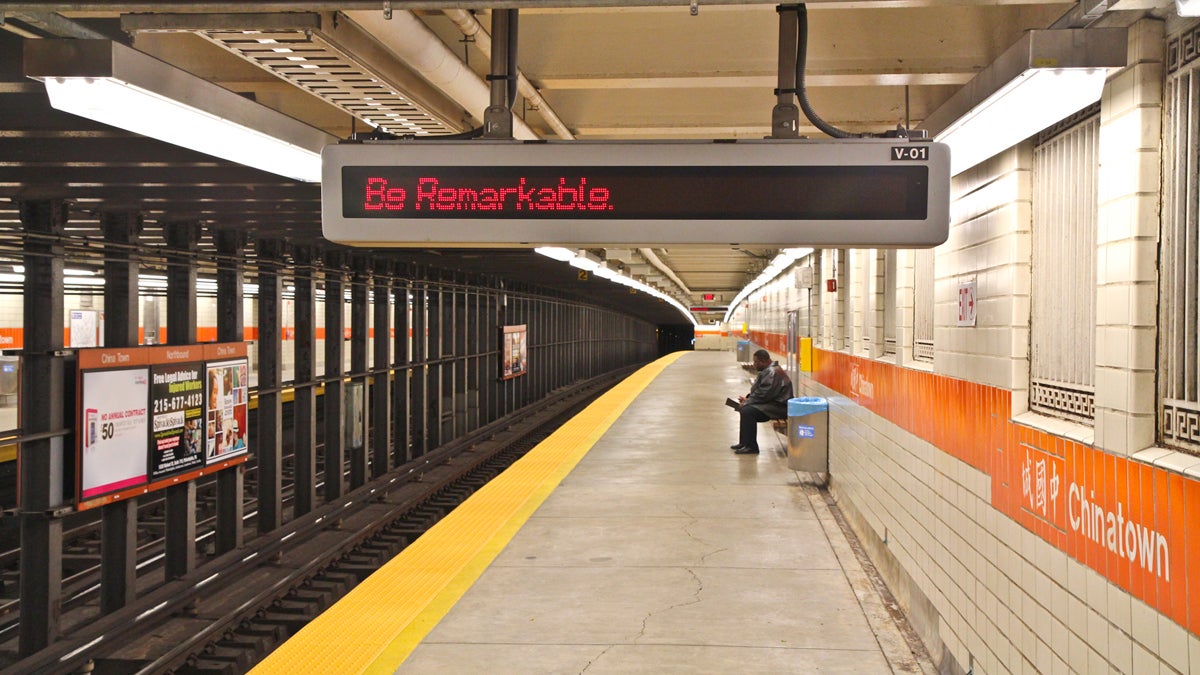SEPTA’s late-night experiment a ‘huge step forward’ into Philly’s future

The platform at the Chinatown stop on the Broad-Ridge spur of the Broad Street Line is shown. (Kimberly Paynter/WHYY, file)
This week SEPTA announced it would return all-night subway service to the city of Philadelphia — a refreshingly progressive move from an organization that, at least in my opinion, has been far less than refreshing in my life’s worth of experiences using it.
I’m 28, I suppose it should be mentioned, born and raised in Fishtown. And through my years in Philly, I’ve either lived or worked in nearly every section of the city. Suffice it to say, I use SEPTA. A lot.
This week’s announcement came on the heels of a petition I started in early March calling for #SEPTA247, a return to 24-hours-a-day, seven-days-a-week Broad Street Line and Market-Frankford el train service. Yes, a return.
What many people didn’t know (myself included) was that SEPTA actually ran its subway trains 24/7 up until 1991, when an extraordinary amount of money was spent to install gates on each and every el and subway station, and the city’s trains stopped running between the hours of midnight and 5 a.m. Why? Mostly because ridership was down and SEPTA was cash strapped — not because of crime, as some have speculated.
Of course, people still needed public transportation during these hours, so SEPTA replaced the trains with “Nite Owl” buses, a service that any Philadelphian can tell you is a beyond-pitiful supplement for the trains. Often late, always packed, and generally not used by anyone with the means to take a cab — as Philebrity put it: “We wouldn’t wish a Night Owl bus on our worst enemy.”
And it’s true. Even as a barista at a Center City café, making minimum wage and usually no more than $10 a day in tips, I would frustratingly fork over 1/3 of my day’s pay to take a cab home at 1 a.m. when my shift ended. By that point in my life, after many more-than-disappointing experiences waiting for, and sometimes even riding, the Nite Owl buses, I had all but thrown out the idea of ever even trying to take one.
Not only are the Nite Owl buses delayed, as they seem to only ever crawl in weekend bar traffic, but they are also way overcrowded. And waiting for these otherwise mythical buses on street corners or under the el for up to 45 minutes feels incredibly unsafe. This is in stark contrast to standing at a brightly lit and security camera-filled el and subway station with an attendant in the booth just a few feet away.
Clearly, this sentiment was felt across the city, as more than 2,500 people signed my #SEPTA247 petition in little more than a couple of weeks, followed by articles written by many of the city’s major blogs and publications, and culminating in a response from SEPTA that they would look into bringing late-night service back and make an official announcement in April.
Which brings us to this week.
SEPTA’s announcement confirms that the organization will begin running the el and subway trains 24 hours a day through the weekend (that means Friday and Saturday nights) beginning in June. SEPTA claims this is a “test period,” running through to Labor Day, to see whether or not this service will be used widely enough to support a year-round extension. I’m more than confident that the city will use the late trains enough to support this. After all, SEPTA ridership is at all-time highs. And if the service was only ever originally taken away because of declining ridership, it only makes sense that the service should return now.
My hope is that this test period goes so well that SEPTA extends late-night trains to seven days a week to support the transportation needs of every Philadelphian.
Either way, this is a huge first step for SEPTA and for Philadelphia. As our city’s population continues to grow, and as businesses continue to pop up all around the city, including our ever-growing bar and restaurant scene, investing in our city’s transportation, no matter the time of day, is an investment in the future of this city and in its people. An investment that is long overdue.
—
Philadelphia born and raised, Conrad Benner is a social media community manager and strategist for a local ad agency, though he may be best known as the force behind the street art blog Streets Dept. He has also written for blogs Philthy Mag and Philebrity.
WHYY is your source for fact-based, in-depth journalism and information. As a nonprofit organization, we rely on financial support from readers like you. Please give today.

